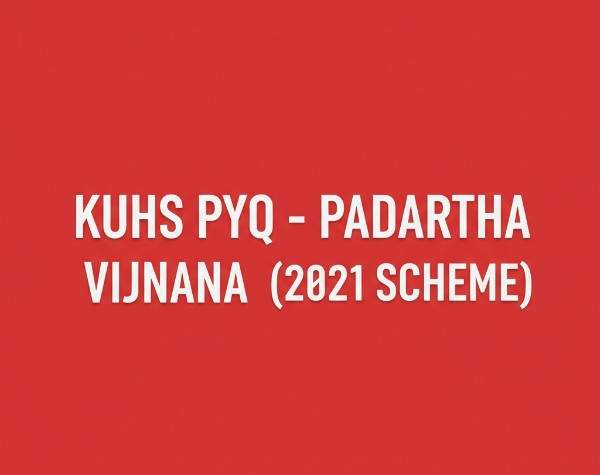
Your Account
Designed by Zeptt Technologies

March 2025
Padarth Vigyan - Paper II
(2021 Scheme)
Time: 3 Hours
Total marks: 100
Answer all questions to the point neatly and legibly. Do not leave any blank pages between answers. Indicate the question number correctly for the answer in the margin space. Answer all parts of a single question together. Leave sufficient space between answers. Draw diagrams wherever necessary.
The Answers to MCQ questions (Q.No. i to Q.No. xx) shall be written continuously on the first two writing sheets (ie Page No. 3 & 4) only.
i. Vyakarana is meant for
a) Vakyarthabodhana
b) Shaktigrahaupaya
c) Shabdarthabodhana
d) None
ii. Nimittagrahana is explained under
a) Samshaya
b) Smrutikarana
c) Tarka
d) None
iii. Lakshana (implication mode) is divided into
a) 4
b) 2
c) 3
d) 1
iv. "Idamkinchit" is
a) Nirvikalpakajnana
b) Savikalpakajnana
c) Anumana
d) Yukti
v. Loka-purushaSāmya Vāda is understood through this Pramāna
a) Pratyaksha
b) Anumana
c) Upamana
d) Yukti
vi. Who admits 'yukti' as a separate pramana
a) Kanada
b) Charaka
c) Susruta
d) Kapila
vii. "Samavayasannikarsha" is related to
a) Shabda and Srotrendriya
b) Rupa and Chakshu
c) Sparsha and Vayu
d) All
viii. According to Ayurveda - Indriyas are
a) Ahamkarika
b) Bhoutika
c) Both
d) None
ix. "Mano anavasthaanat" is a
a) Aptopadeshagamya bhava
b) Pratyakshabadhaka bhava
c) Anumanagamya bhava
d) None
x. Agni of the patient can be examined through
a) Aptopadesha
b) Arthagrahana
c) Vyayamashakti
d) Jaranashakti
xi. Which is sapaksha in the inference of fire
a) Mahanasa
b) Jalashaya
c) Parvata
d) None
xii. Nischita Sadhyabhavavan
a) Paksha
b) Vipaksha
c) Sapaksha
d) Ahetu
xiii. Prakaranasama is
a) Ahetu
b) Hetu
c) Paksha
d) Sadhya
xiv. "Ksheneutpatti, kshanesthithi, kshanenasha" refers to
a) Satkaryavada
b) Asatkaryavada
c) Vivartavada
d) Kshanabanguravada
xv. Swabhavoparamavada is explained by
a) Charvaka
b) Charaka
c) Sushruta
d) Jaina
xvi. Nigamana in Panchavayavavakya is
a) Statement
b) Reasoning
c) Discussion
d) Conclusion
xvii. "Pratyakshapurvam trividham trikalam" is said in relation with
a) Yukti
b) Prathyaksha
c) Anumana
d) Shabda
xviii. "Tanturoopam pataroopasya" is an example of.
a) Asamavayi
b) Samavayi
c) Nimitha
d) None of these
xix. Arambhavada is postulated by
a) Mimamsa
b) Samkhya
c) Yoga
d) Nyaya
xx. Aithihya Pramana can be included under
a) Pratyaksha
b) Aptopadesha
c) Upamana
d) Anumana
Describe Rogapareeksha through Aptopadesha.
Vakyarthajnanahetu.
Write about Indriya Pancha-panchaka.
Explain Pratyakshānupalabdhi Kārana with clinical examples.
Define Upamāna, its types and importance in Ayurveda.
Explain Asatkaryavada in detail.
Explain Panchavayavavakya with an example.
Explain yuktipramana.
Define Parmana, Pramata, Prama and Prameya. Write the different Pramana accepted by different scholars.
Define Pratyaksha. Explain the types and write about Shadvidhasannikarsha.
Explain the Anumana Pramana and Hetvabhasa according to Nyaya Darshana.
Describe the divisions of cause and the satkaryavada.
*****************************
March 2025
Padarth Vigyan - Paper II
(2021 Scheme)
Time: 3 Hours
Total marks: 100
Answer all questions to the point neatly and legibly. Do not leave any blank pages between answers. Indicate the question number correctly for the answer in the margin space. Answer all parts of a single question together. Leave sufficient space between answers. Draw diagrams wherever necessary.
The Answers to MCQ questions (Q.No. i to Q.No. xx) shall be written continuously on the first two writing sheets (ie Page No. 3 & 4) only.
i. Vyakarana is meant for
a) Vakyarthabodhana
b) Shaktigrahaupaya
c) Shabdarthabodhana
d) None
ii. Nimittagrahana is explained under
a) Samshaya
b) Smrutikarana
c) Tarka
d) None
iii. Lakshana (implication mode) is divided into
a) 4
b) 2
c) 3
d) 1
iv. "Idamkinchit" is
a) Nirvikalpakajnana
b) Savikalpakajnana
c) Anumana
d) Yukti
v. Loka-purushaSāmya Vāda is understood through this Pramāna
a) Pratyaksha
b) Anumana
c) Upamana
d) Yukti
vi. Who admits 'yukti' as a separate pramana
a) Kanada
b) Charaka
c) Susruta
d) Kapila
vii. "Samavayasannikarsha" is related to
a) Shabda and Srotrendriya
b) Rupa and Chakshu
c) Sparsha and Vayu
d) All
viii. According to Ayurveda - Indriyas are
a) Ahamkarika
b) Bhoutika
c) Both
d) None
ix. "Mano anavasthaanat" is a
a) Aptopadeshagamya bhava
b) Pratyakshabadhaka bhava
c) Anumanagamya bhava
d) None
x. Agni of the patient can be examined through
a) Aptopadesha
b) Arthagrahana
c) Vyayamashakti
d) Jaranashakti
xi. Which is sapaksha in the inference of fire
a) Mahanasa
b) Jalashaya
c) Parvata
d) None
xii. Nischita Sadhyabhavavan
a) Paksha
b) Vipaksha
c) Sapaksha
d) Ahetu
xiii. Prakaranasama is
a) Ahetu
b) Hetu
c) Paksha
d) Sadhya
xiv. "Ksheneutpatti, kshanesthithi, kshanenasha" refers to
a) Satkaryavada
b) Asatkaryavada
c) Vivartavada
d) Kshanabanguravada
xv. Swabhavoparamavada is explained by
a) Charvaka
b) Charaka
c) Sushruta
d) Jaina
xvi. Nigamana in Panchavayavavakya is
a) Statement
b) Reasoning
c) Discussion
d) Conclusion
xvii. "Pratyakshapurvam trividham trikalam" is said in relation with
a) Yukti
b) Prathyaksha
c) Anumana
d) Shabda
xviii. "Tanturoopam pataroopasya" is an example of.
a) Asamavayi
b) Samavayi
c) Nimitha
d) None of these
xix. Arambhavada is postulated by
a) Mimamsa
b) Samkhya
c) Yoga
d) Nyaya
xx. Aithihya Pramana can be included under
a) Pratyaksha
b) Aptopadesha
c) Upamana
d) Anumana
Describe Rogapareeksha through Aptopadesha.
Vakyarthajnanahetu.
Write about Indriya Pancha-panchaka.
Explain Pratyakshānupalabdhi Kārana with clinical examples.
Define Upamāna, its types and importance in Ayurveda.
Explain Asatkaryavada in detail.
Explain Panchavayavavakya with an example.
Explain yuktipramana.
Define Parmana, Pramata, Prama and Prameya. Write the different Pramana accepted by different scholars.
Define Pratyaksha. Explain the types and write about Shadvidhasannikarsha.
Explain the Anumana Pramana and Hetvabhasa according to Nyaya Darshana.
Describe the divisions of cause and the satkaryavada.
*****************************